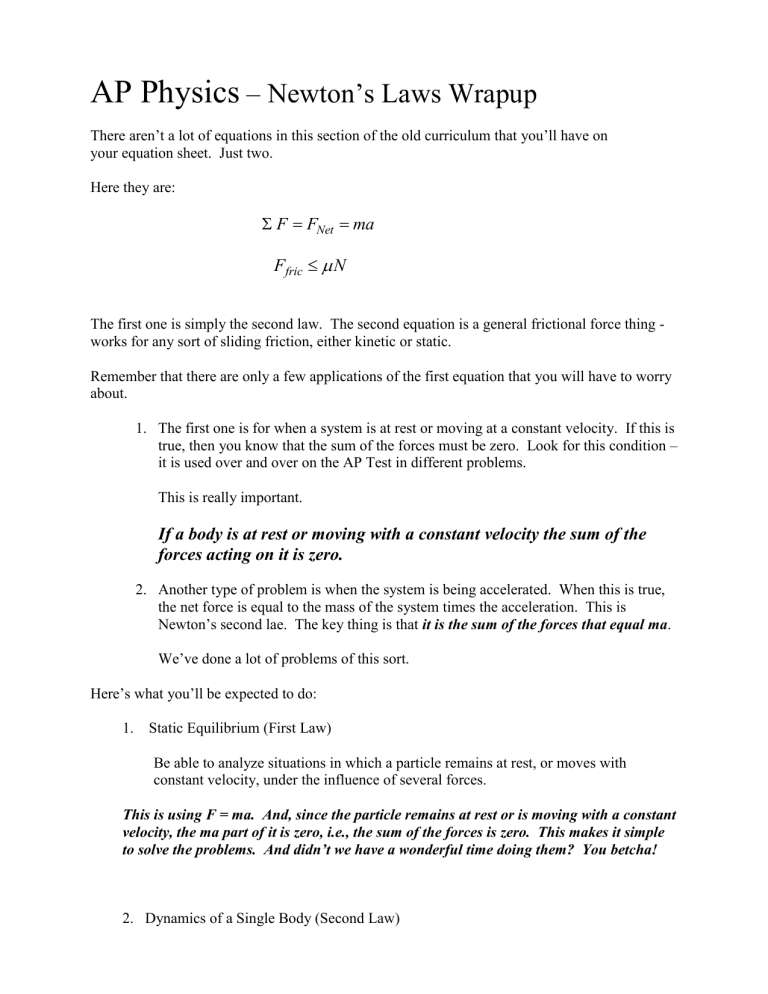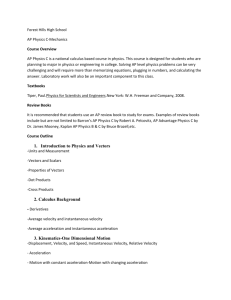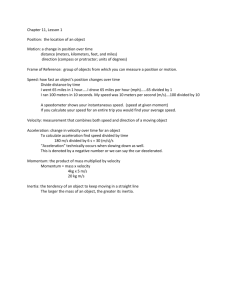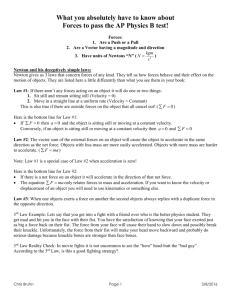Wrap -Up Notes

AP Physics
– Newton’s Laws Wrapup
There aren’t a lot of equations in this section of the old curriculum that you’ll have on your equation sheet. Just two.
Here they are:
F
Net
F fric
ma
N
The first one is simply the second law. The second equation is a general frictional force thing - works for any sort of sliding friction, either kinetic or static.
Remember that there are only a few applications of the first equation that you will have to worry about.
1.
The first one is for when a system is at rest or moving at a constant velocity. If this is true, then you know that the sum of the forces must be zero. Look for this condition – it is used over and over on the AP Test in different problems.
This is really important.
If a body is at rest or moving with a constant velocity the sum of the forces acting on it is zero.
2.
Another type of problem is when the system is being accelerated. When this is true, the net force is equal to the mass of the system times the acceleration. This is
Newton’s second lae. The key thing is that it is the sum of the forces that equal ma .
We’ve done a lot of problems of this sort.
Here’s what you’ll be expected to do:
1.
Static Equilibrium (First Law)
Be able to analyze situations in which a particle remains at rest, or moves with constant velocity, under the influence of several forces.
This is using F = ma. And, since the particle remains at rest or is moving with a constant velocity, the ma part of it is zero, i.e., the sum of the forces is zero. This makes it simple to solve the problems. And didn’t we have a wonderful time doing them? You betcha!
2.
Dynamics of a Single Body (Second Law)
a.
You should understand the relation between the force that acts on a body and the resulting change in the body’s velocity so you can:
(1) Calculate, for a body moving in one direction, the velocity change that results when a constant force F acts over a specified time interval.
Use F = ma to solve for acceleration. Then use the acceleration to find the velocity using the kinematic equations. Piece of pie.
(2) Calculate, for a body moving in one dimension, the velocity change that results when a force F acts over a specified time interval.
Pretty much the same thing as above.
(3) Determine, for a body moving in a plane whose velocity vector undergoes a specified change over a specified time interval, the average force that acted on the body.
Pretty much the same stuff as above except that you solve for the force using acceleration and mass. b.
You should understand how Newton’s Second Law,
F = ma applies to a body subject to forces such as gravity, the pull of strings, or contact forces so you can:
(1) Draw a well-labeled diagram showing all real forces that act on the body.
This is the good old FBD, free body diagram deal. By now you should be one of the best FBD drawers in the whole of the known universe! Always draw a FBD for force problems. The graders will no doubt be lulled into the belief that you know what you are doing if you make a nice force drawing. Could get you a couple of undeserved extra points.
(2)
Write down the vector equation that results from applying Newton’s Second Law to the body, and take components of this equation along appropriate axes.
We did this with the whole vector component addition thing. You have been trained to do this. c.
You should be able to analyze situations in which a body moves with specified acceleration under the influence of one or more forces so you can calculate the magnitude and direction of the net force, or of one of the forces that makes up the net force, in situations such as the following:
(1) Motion up or down with constant acceleration (in an elevator, for example).
We did many of these. Draw a FBD! d.
You should understand the significance of the coefficient of friction so you can:
(1) Write down the relationship between the normal and frictional forces on a surface.
This is the F fric
N equation. If everything is horizontal, then the normal force is just the weight. If, however, the applied forces have vertical components, you will have to solve for the normal force. It won’t be the weight. If this doesn’t make sense, go back to the handout and your carefully taken notes and do some practice problems until it does make sense.
(2) Analyze situations in which a body slides down a rough inclined plane or is pulled or pushed across a rough surface.
No doubt the friction on the ramp problems were your personal favorites. Here you’ve got to deal with the components of the forces that are parallel to the ramp and perpendicular to it. You are well trained in how to do this.
(3) Analyze static situations involving friction to determine under what circumstances a body will start to slip, or to calculate the magnitude of the force of static friction.
This is simply the use of the F fric
N equation. The body will start to slip when the static frictional force is exceeded. If it isn’t exceeded, then the object won’t move.
3.
Systems of Two or More Bodies (Third Law) a.
You should understand Newton’s Third Law so that, for a given force, you can identify the body on which the reaction force acts and state the magnitude and direction of this reaction.
Well, you shouldn’t have any trouble doing this. b.
You should be able to apply Newton’s Third Law in analyzing the force of contact between two bodies that accelerate together along a horizontal or vertical line, or between two surfaces that slide across one another.
This means friction problems. You have survived a great many of these problems, so they should now be pie. c.
You should know that the tension is constant in a light string that passes over a massless pulley and should be able to use this fact in analyzing the motion of a system of two bodies joined by a string.
Ditto on this.
You’ve solved bunches of problems like the ones described above, so you should be good to go on this section.
Here’s one we looked at after the last unit. There were some parts that we couldn’t do back then.
But we can do’em now! This one, you will recall, is from 1998.
Two small blocks, each of mass m , are connected by a string of constant length 4 h and negligible mass. Block A is placed on a smooth tabletop as shown below, and block B hangs over the edge of the table. The tabletop is a distance 2 h above the floor. Block B is then released from rest at a distance h above the floor at time t = 0. a.
Determine the acceleration of block B as it descends.
We analyze the forces on each block:
Note that the table is “smooth” so we assume there is no sliding friction.
The FBD for each block is shown to the right.
F
A
ma
T ma
T
A
T
T
F
B
ma ma
Two unknowns and two equations. Got to solve them simultaneously or something.
Hey, presto, why not add the two equations together: ma
ma T mg
T
The two tension terms annihilate one another.
B mg ma
ma
mg 2 ma
mg 2 a
g a
g
2 b.
Block B strikes the floor and does not bounce. Determine the time t
1
at which block B strikes the floor. y
1
2 at
2 t
2 y a
2 h t
4 h g
2 h g c.
Describe the motion of block A from time t =0 to the time when block B strikes the floor.
It will accelerate at the same rate as B, a
g
, till B hits the floor.
2 d.
Describe the motion of block A from the time block B strikes the floor to the time block
A leaves the table.
No force is acting on it, so it moves at constant velocity due to Newton’s first law – its inertia. e.
Determine the distance between the landing points of the two blocks. v
at v
2 h g
v
hg
1 y gt
2
2
2
1 h gt
2
2 t
4 h g x
v t o x x
2 h g
x
2
Okay, one more problem.
Three blocks of masses 1.0, 2.0, and 4.0 kilograms are connected by massless strings, one of which passes over a frictionless pulley of negligible mass, as shown. Calculate each of the following. h a.
The acceleration of the 4 kilogram block.
We can treat the two masses on the opposite side of the pulley from the 4.0 kg block as a single block of 3.0 kg, since we don’t have to find out anything for them.
Here is the FBD for the blocks:
We sum the forces:
F
2
m a
m g
T
T T
Add the two equations:
m a
m g
T
m a m a
m a
m g
m g
m g
2
m
1
m a
m a
m g
T
T
m g
2
m
1
a
g
m
2
m
1 m
2
m
1
a
m
9.8
s
2
4
4 kg
3 kg kg
3 kg
m
1.4
s
2 b.
The tension in the string supporting the 4 kilogram block. m a
m g
T
T
m g
m a
T
m
2
g
a
T
kg m
4 9.8
1.4
2 s
m s
2
34 N c.
The tension in the string connected to the 1 kilogram block.
The string connecting the two weights holds 1.0 kg instead of 3 kg. So it is probably
1/3 the answer in part b, or 11 N.
Here’s the FBD for all three weights. The small 1.0 kg mass has been designated as
m
.
If we look at the sum of the forces on it, we get:
F s
m a
T
2
m g
T
2
m a
m g
g
T
2
1.0
kg 1.4
m s
2
9.8
m s
2
11 N
Senseless Information:
In the United States, more Frisbee discs are sold each year than baseballs, basketballs, and footballs combined.
There is no rice in rice paper.
Tibetans, Mongolians, and people in parts of western China put salt in their tea instead of sugar.
TYPEWRITER, is the longest word that can be made using the letters on only one row of the keyboard.
Until 1990, sausages were still legal tender in East Germany.
When the Hoovers did not want to be overheard by White House guests, they spoke to each other in Chinese.






